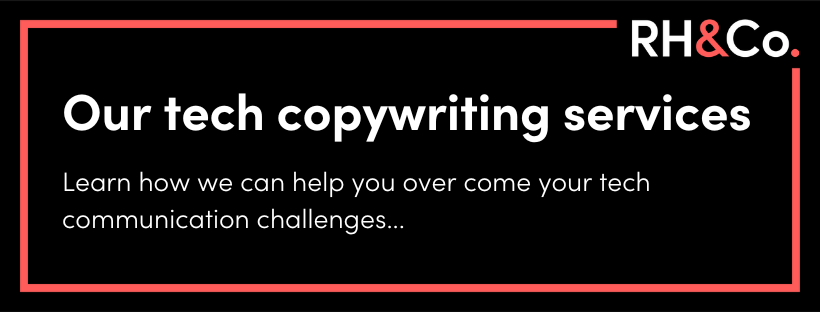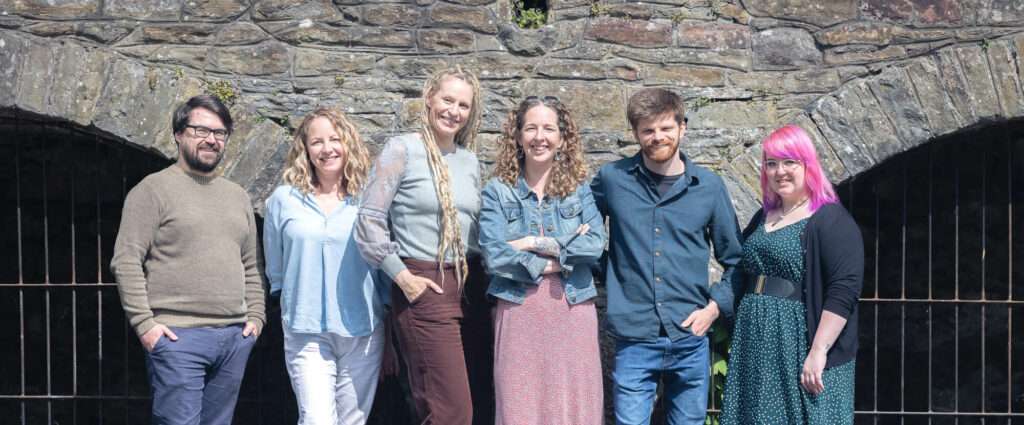

Disrupt or die: How technology marketers can hone their brand’s edge
As a technology brand, you’re always breaking new ground. That’s a tough enough task in itself. Before long though, another brand is breaking the ground you’re currently standing on. This is the circle of life in the startup, scaleup and enterprise world, and it requires some nifty work from marketers to create a strategy that doesn’t get swallowed by the shifting landscape.
This is the last article in our series on brand challenges in the technology market – and in case you missed them, you can sidle over to our thoughts on how to market complex technology and how to do it in a fast-moving industry.
Right now though, we’re going to dive into what makes this market so precarious: you’re disrupting or you’re in danger of disruption. And for brand marketers, this means you’re facing a tricky set of challenges.
TL:DR
- Challenge 01: Disruptors need to change the rules of engagement
- Challenge 02: You’re reaching the disillusioned or neglected
- Challenge 03: You can’t build forever on a foundation of disruption
Challenge 01: Disruptors need to change the rules of engagement
If you’re a disruptive business, you’re not just trying to improve the way things are done, you’re trying to fundamentally change them. That could be as simple as switching the standard of social media content from curated pictures to scrappy 30 second videos, or it could be as complex as changing the way enterprises procure and pay their supply chain.
If your onboarding process takes minutes, and if there’s no cost or a negligible one, you have an advantage here: you can take people straight to proof of concept.
That’s definitely not the case for every brand though. What if your disruptive technology requires a minimum investment of £20,000? Or if onboarding is going to take several months? Or if your users are going to need to upend their techstack?
Here you’ve got your work cut out for you. You can’t rely on people trying your product to see that it’s so much better than the way things used to be. So what can you do to change the rules of engagement?

Solution 01: First convince people a new idea is true or possible
Behind every disruptive product lies a disruptive idea, such as:
- Ethical clothing doesn’t have to be artisan
- Instant coffee can be as good as barista coffee
- Any house or room can be an airbnb
The trouble is that in technology this premise is often far more complex:
- Open loop payment systems are better than closed loop
- Embedded finance is the future of SaaS
- An employee’s experience of the internet is an HR issue
- Mobile QA tooling is broken without automated, end-to-end testing on real devices
Yes, there is a small subsection of the universe that will get it at first glance. They’ll probably be your early adopters. But the rest will need to understand the context first (why is mobile QA tooling broken? What are the limitations of closed loop systems?)
You might be able to communicate what you need with a single, ingenious line. Like the 2014 campaign “Slack replaces email in your company,” or UiPath’s “We make robots so people don’t have to be robots.” Or, to take a favourite one-liner from our client Weavr: “We help cloud accounting apps move cash, not just watch it.”
That’s rarely enough on its own though. Some of your audience will need more detail before they’ll believe a new idea. Our client BaseKit wants to help big businesses understand that micro businesses need better access to new technology. To drive that premise home, we created an 8,000-word report with original research, interviews and stories.
Challenge 02: You’re reaching the disillusioned or neglected
Disruptive technology rarely starts out by targeting the mainstream. It usually goes after the outliers, the excluded, and the underserved, who either feel overlooked or actually are overlooked by the current products on the market.
That’s an opportunity, but it’s also a challenge. As an example, your audience of small businesses and sole traders might not have had a reason to care about accounts payable and receivable technology before – they couldn’t afford it and they didn’t have the time to learn to use it. Historically your product would be totally irrelevant and out of reach. You have to convince them they’re now included.
Alternatively they might be a disillusioned or disengaged audience – for instance, a Gen Z employee, an entrepreneur from a BAME background, or a team of developers who are tired of using catch-all platforms like Google Firebase to build products. Your task is to show them you relate to their pain and you have the beginnings of a cure.
Solution 02: Show empathy before you sell
In some ways this is marketing 101 but sometimes the simplest principles are the toughest to execute on well.
Particularly in technology, it’s easy to get straight to the features, the metrics and the bottom line benefits. First though, it’s best to take a moment to talk like a human. That’s ultimately what will cut through the disillusionment or alienation that your audience is currently experiencing.
Storytelling is your biggest ally here. We’re talking real stories from real humans, ideally talking from the heart. It’s a great opportunity for:
- Expert-authored articles
- User-generated content
- Employee-generated content
- Influencers
- Interviews
For instance, one of our clients wanted to shine a spotlight on the transit system of California. In that state, it’s typically only the poor that travel by bus. Our client wanted to serve that community while creating a payment system that attracted new riders, so that the whole transit system could become a better funded, green alternative to driving in the region.
It’s not just the riders that felt disenfranchised here, it’s the bus agencies too. One glance at a neighbouring big city’s metro system tells you “this has funding”. But the rest of the region was stumbling along with antiquated or non-existent technology.
To set the stage for a new norm, we created a campaign, full of stories, interviews and real world examples. All of these showed how a new, accessible, affordable technology changed everything: these poorly-funded bus agencies could create a transit experience that rivals the big cities.

Challenge 03: You can’t build forever on a foundation of disruption
The truth is, you’re never a disruptor brand for that long – in tech, everything simply moves too fast.
You may start at the low end of the market but to expand you’ll need to appeal to premium or enterprise customers too. Or you begin by helping one community but pretty soon you’re trying to help many communities. Now you have investors, client expectations to meet and newcomer competitors who are right behind you.
Although they’re often held up as an example, Uber is no longer disruptive. They’re being chased down by the carbon neutral Bolt, the VAT-paying Kapten and community-focused brands like the woman-exclusive London Lady Chauffeurs. Uber has to stay ahead by providing more features and better quality control – and whether they’ll succeed, only time will tell.
If you’re going to defend your position, you’re better off finding the stories and parts of your feature-set that appeal to the emotional makeup of your audience.
Likewise, Slack once summarised their offering rather elegantly in the phrase “Slack replaces email in your company.” It was disruptive and interesting at the time but now there are plenty of solutions that replace email. So the company’s current campaigns focus on discounts, big feature lists (“over 1800 integrations!”), and a confidence vote from other established brands like Spotify.
This might not be the ideal way to do it but brands do need to grow up a bit eventually. As Deloitte put it in their 2023 tech trends report: “Startups often embrace the mantra ‘move fast and break things.’ It’s easier for them to be disruptive because they’re definitionally starting from zero and don’t yet have a legacy to protect. Established organisations, on the other hand, very much do.”
You can’t build on a foundation of disruption forever, so what do you do next?
Solution 03: Find the heart of your brand and keep it fired up
It’s a natural fact of life in the startup to scaleup world: your brand must evolve. Your last campaign is no recipe for the next one, and your core brand message might no longer resonate with your new target audience. You need to stay relevant while staying in touch with what made your company special in the first place.
For instance, new Slack-like SaaS platforms such as Mattermost and Rocket.Chat are taking on the juggernaut by staying open source – a point that instantly endears them to developers and sets them apart from incumbents like Slack and Microsoft Teams.
The trick will be, once every work platform is eventually open source, to know what their differentiator will be then. They could join the feature/discount/price race and try to live on historic gains in brand recognition. This does work for some, after all. But “more, better, cheaper” is a tiring message to keep up, and it’s one that’s vulnerable to the more emotionally-resonant messaging of new competitors.
And there is an alternative and more compelling option. If you’re going to defend your position, you’re better off finding the stories and parts of your feature-set that appeal to the emotional makeup of your audience.
For instance, one of our clients has created extremely sophisticated software that’s years ahead of other brands. Even though there are new digital-native offerings out there now, the newcomer software is scrappy to the point of being non-compliant and incomplete. Meanwhile our client’s solution is watertight – so they double down on this in all their messaging, bringing home the sense that they are the smarter brand.
You can’t always play the scrappy startup game. You can’t focus on your MVP’s single feature for all time. But you can stay distinctive – you just need to engineer your brand at the right time.
Back to hompeage









